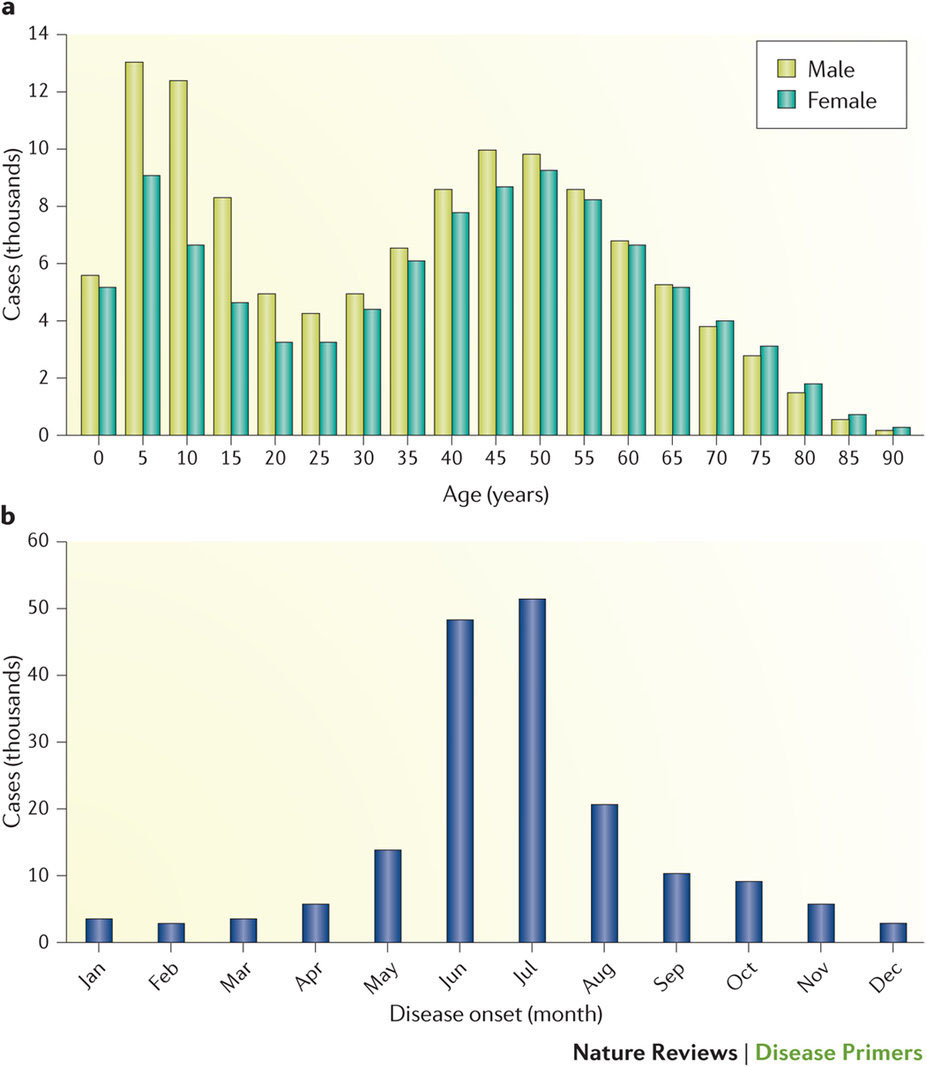ライム病
Lyme borreliosis
2016年12月15日 Nature Reviews Disease Primers Article number: 16090 (2016) doi: 10.1038/nrdp.2016.90

ライム病(ライムボレリア症)は、主に北半球の温帯地域で発生するダニ媒介疾患である。北米ではBorrelia burgdorferiが、ヨーロッパやアジアではBorrelia afzelii やBorrelia garinii が起因菌になる。感染すると、通常、遊走性紅斑と呼ばれる周囲に拡大する皮膚病変が発現し(第1期)、治療をしなければ、主に神経学的異常が生じる早期播種性感染症(第2期)に移行し、晩期感染(第3期)になると、特に北米では関節炎、ヨーロッパでは慢性萎縮性肢端皮膚炎などの症状が現れる。しかし、これらの症状はいずれも病気に関係なく現れることがある。感染が成立すると、原因菌は宿主の組織中を移動し、特定の細胞に接着することで、免疫クリアランスを回避することができる。最終的に、これらの細菌は宿主の自然免疫と獲得免疫の両方によって排除されるため、感染よる炎症症状はほとんど抑制される。遊走性紅斑がある場合を除いて、ライム病の診断は、この感染症の血清学的検査の結果とあわせて、臨床上特徴的な徴候や症状の組合せに基づいて行われる。通常、ライム病の症状はいずれも、適切な抗菌薬治療によって抑えることができるが、一部の患者では感染症の後遺症が持続することがある。ライム病の予防は、各自の防護対策によるダニ刺咬の回避が中心になる。
PrimeView
ライム病は、Borrelia burgdorferi sensu latoの3つの遺伝種を起因菌とするダニ媒介疾患であり、特徴的な皮膚病変、神経症状および心血管症状が現れる。このPrimeViewではライム病の疫学を中心に取りまとめる。
本Primerの図解サマリー
Lyme borreliosis is a tick-borne disease that predominantly occurs in temperate regions of the northern hemisphere and is primarily caused by the bacterium Borrelia burgdorferi in North America and Borrelia afzelii or Borrelia garinii in Europe and Asia. Infection usually begins with an expanding skin lesion, known as erythema migrans (referred to as stage 1), which, if untreated, can be followed by early disseminated infection, particularly neurological abnormalities (stage 2), and by late infection, especially arthritis in North America or acrodermatitis chronica atrophicans in Europe (stage 3). However, the disease can present with any of these manifestations. During infection, the bacteria migrate through the host tissues, adhere to certain cells and can evade immune clearance. Yet, these organisms are eventually killed by both innate and adaptive immune responses and most inflammatory manifestations of the infection resolve. Except for patients with erythema migrans, Lyme borreliosis is diagnosed based on a characteristic clinical constellation of signs and symptoms with serological confirmation of infection. All manifestations of the infection can usually be treated with appropriate antibiotic regimens, but the disease can be followed by post-infectious sequelae in some patients. Prevention of Lyme borreliosis primarily involves the avoidance of tick bites by personal protective measures.

